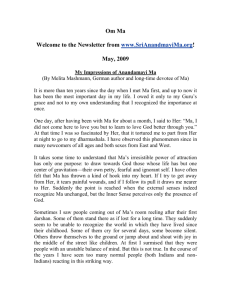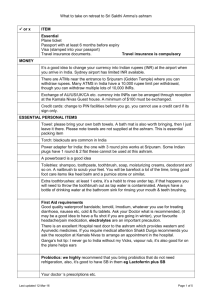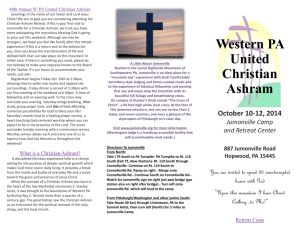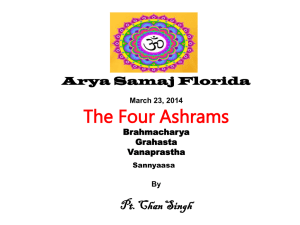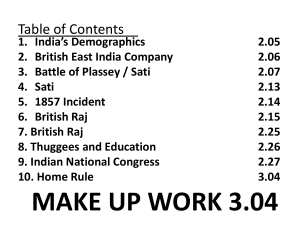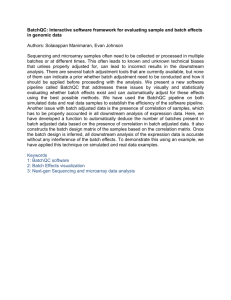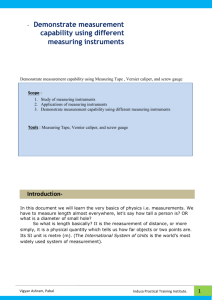Bal Ashram (Children`s Sanctuary)
advertisement
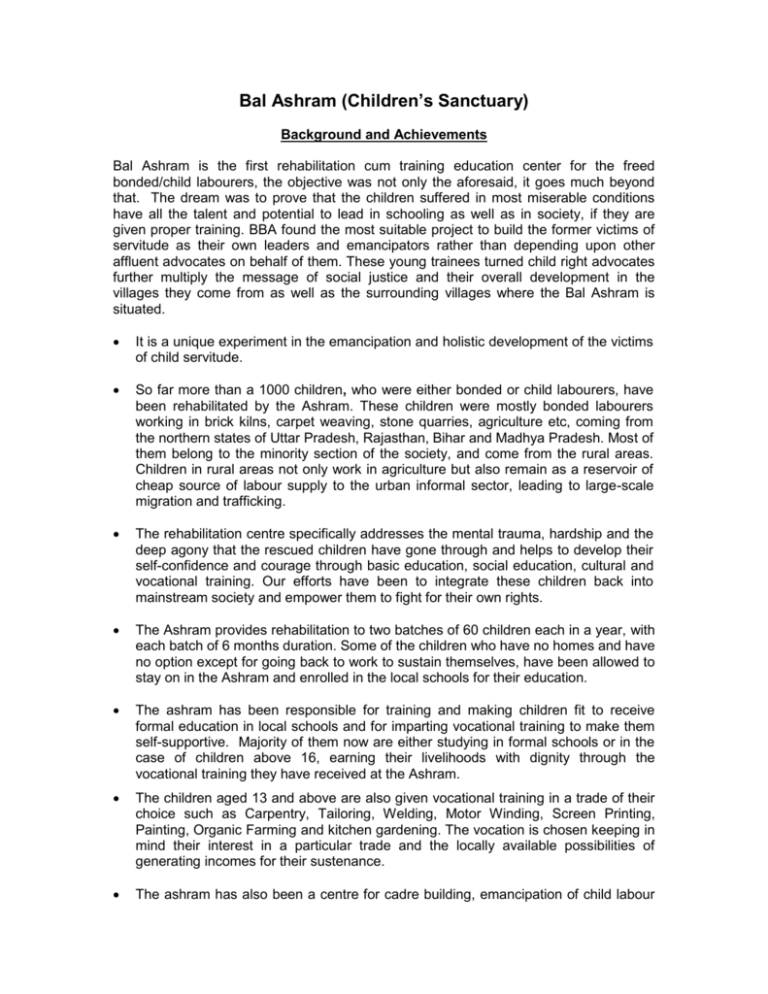
Bal Ashram (Children’s Sanctuary) Background and Achievements Bal Ashram is the first rehabilitation cum training education center for the freed bonded/child labourers, the objective was not only the aforesaid, it goes much beyond that. The dream was to prove that the children suffered in most miserable conditions have all the talent and potential to lead in schooling as well as in society, if they are given proper training. BBA found the most suitable project to build the former victims of servitude as their own leaders and emancipators rather than depending upon other affluent advocates on behalf of them. These young trainees turned child right advocates further multiply the message of social justice and their overall development in the villages they come from as well as the surrounding villages where the Bal Ashram is situated. It is a unique experiment in the emancipation and holistic development of the victims of child servitude. So far more than a 1000 children, who were either bonded or child labourers, have been rehabilitated by the Ashram. These children were mostly bonded labourers working in brick kilns, carpet weaving, stone quarries, agriculture etc, coming from the northern states of Uttar Pradesh, Rajasthan, Bihar and Madhya Pradesh. Most of them belong to the minority section of the society, and come from the rural areas. Children in rural areas not only work in agriculture but also remain as a reservoir of cheap source of labour supply to the urban informal sector, leading to large-scale migration and trafficking. The rehabilitation centre specifically addresses the mental trauma, hardship and the deep agony that the rescued children have gone through and helps to develop their self-confidence and courage through basic education, social education, cultural and vocational training. Our efforts have been to integrate these children back into mainstream society and empower them to fight for their own rights. The Ashram provides rehabilitation to two batches of 60 children each in a year, with each batch of 6 months duration. Some of the children who have no homes and have no option except for going back to work to sustain themselves, have been allowed to stay on in the Ashram and enrolled in the local schools for their education. The ashram has been responsible for training and making children fit to receive formal education in local schools and for imparting vocational training to make them self-supportive. Majority of them now are either studying in formal schools or in the case of children above 16, earning their livelihoods with dignity through the vocational training they have received at the Ashram. The children aged 13 and above are also given vocational training in a trade of their choice such as Carpentry, Tailoring, Welding, Motor Winding, Screen Printing, Painting, Organic Farming and kitchen gardening. The vocation is chosen keeping in mind their interest in a particular trade and the locally available possibilities of generating incomes for their sustenance. The ashram has also been a centre for cadre building, emancipation of child labour through the medium of children themselves. Many of these children have returned to their native villages and become change makers by raising their voices against child labour, illiteracy and other social evils in their respective provinces. The children are taught to be nature friendly and preserve its sanctity. The culture of living with different religions and different castes, without bias and prejudices is inculcated in them during their stay at the ashram. Children are also imparted physical education and first aid training to deal with exigencies. Apart from this, children also undergo some edification regarding our cultural traditions and contentious social and environmental issues. Children are encouraged to participate in demonstrations, rallies and marches highlighting social problems prevailing in the local area. The children are given adequate information and support to design campaigns. The purpose is to make them able citizens to fight for their rights as well as for others who are in bondage and exploitation. The institution has also been a venue for capacity building and empowerment of local women, with women joining the elected village board of panchayats (local selfgovernance). It has also organised various workshops/orientation programmes on the issue of gender and women’s rights to make them stand up against exploitation and social evils. Bal Ashram is also exerting tremendous influence on the neighbouring villages through the implementation of model child friendly villages in the vicinity, which aims at the elimination of child labour, their enrolment into schools through active community participation and the establishment of Children’s parliaments. The ashram also regularly organises programmes in schools and villages to build awareness on child labour. It has provided a platform to sensitise the local community especially the women to raise social issues. Children from the Bal Ashram have been part of the activities of BMG and interacting with villagers and children in the surrounding villages to advocate for a child friendly society. Children passing out from the Bal Ashram have also been taking part in the activities of ‘Mukti Caravan’ or ‘Caravan on Wheels’, in which children travel from village to village in a caravan, spreading awareness on the issues of child labour and education through street plays, songs, meetings etc. The most visible results are, however, that each and every child applies something or the other that they have learned at the Ashram. Follow-up cases show that most of the children have been successful in stopping their fathers and other close relatives from alcohol abuse. A number of them have insisted that their sisters attend school too. Domestic violence and the abuse of women in the family have also substantially reduced. The children progressively imbibe all these lessons at the Ashram. They had been seeing all these ills from the time they were born, not deeming them to be wayward in any manner. Exposure to the Ashram allows its values gradually to penetrate them, making them into changed human beings once they go back. It has been seen that each and every boy becomes sufficiently empowered to effect some change or the other, in their families, their village or in the community. Bal Ashram Activities Formal and Non-Formal Education: The Ashram has been rendering facilities for nonformal education to children in the Ashram premises. Since most of these children have never been to school, education is provided to them with the objective of equipping the children with some reading and writing skills, so as to generate their interest towards education, with the ultimate goal of strengthening their skills of understanding and aptitude. Vocational Training: The children aged 13 and above are also given vocational training in a trade of their choice such as Carpentry, Tailoring, Welding, Motor Winding, Screen Printing, Painting, Organic Farming and kitchen gardening. The vocation is chosen keeping in mind their interest in a particular trade and the locally available possibilities of generating incomes for their sustenance. Social Education: To build social awareness in the children, training is imparted to them to fight against social evils like illiteracy, child labour, dowry, corruption, child marriage etc. Efforts are also made to make the children introspect on social issues with a view to moulding them into responsible and self-reliant citizens. The Ashram also encourages them to look after the running of the institution to teach them the basics of management. Cultural Education: Various programmes are also organised from time to time in order to infuse a sense of pride and cultural awareness amongst the children. They are also encouraged to participate in folk songs, patriotic songs, slogan making, theatre, plays etc Physical Education & Sports: Equal focus is also given to improve the physical as well as mental health of the children by regular practice of yoga, meditation, sports etc. They are also given training in personal hygiene and etiquette. Group Discussion: The children are encouraged to debate and discuss on aspects of child labour and other social issues. By using cards and booklets on Panchayati Raj Institution - PRI (local governance), efforts are made to impart a basic training on their role in the society. Awareness on Environment: A lot of thrust is given to make the children environmentfriendly by educating them on the environment and nature. Plantation camps are organized, where the children plant saplings along the sides of roads, in Ashram premises etc. Excursions: Children are also taken on outings / excursion tours to wild life sanctuaries and other historic and important sites, to give them exposure and knowledge on various issues. Campaigns: Children are encouraged to participate in demonstrations, rallies and marches highlighting social problems prevailing in the local area. The children are given adequate information and support to design campaigns. The purpose is to make them confident and able citizens to fight for their rights as well as for others who are in bondage and exploitation. Management Training & Leadership Development Initiative: During their training period the children/youth are encouraged to learn some managerial skills. Bal Ashram facilitates a Bal panchayat of children in the Ashram itself through proper elections. The children also elect various committees like watch and ward, sports and games, social and cultural, campus management and discipline, and kitchen store purchase. The leaders of these committees closely work with the teachers and other staff, learn and advice. Follow up Activities: BBA staff keeps track of children leaving the ashram for their homes after the rehabilitation process is over. Children are persuaded to communicate regularly with the Bal Ashram staff as well as the local volunteers in their area and with other children. It is encouraging to learn that many ex- trainees have become economically independent in their villages. Some have joined schools and others have become active social workers, helping parents in their area get admissions into schools for their children, pressurising the local administration to appoint teachers (where required) etc. Convocation: a farewell cum gathering would be organised for the children graduating from the Ashram twice a year. Media, villagers, senior leaders of the organisation and other stakeholders would be invited to attend the programme. The idea is to disseminate the successful rehabilitation of the bonded/child labourers, through a model transit rehabilitation center. Other Activities: The Ashram also ensures that its children are taken care of in every way, by taking necessary actions. For instance, one of the children at the Bal Ashram, who had bent legs, was operated on and surgery done on his legs. The operation was very successful and the child is now recovering from surgery. PROJECT BUDGET Organization: Bal Ashram Trust Project Title: Education Center For Released Child Labourers Budget Date:22nd August 2006 Exchange Rate: Rate of Conversion: 1 USD = 46 INR Activity 1: Education and Vocational Training N o . Item Unit cost per child per month(l ocal currenc y) Unit cost per child per month( USD) Quantity Co mm unit y/ Request ed amount (USD) org. con trib utio n (US D) 1 Education 350 7.60 60 children per batch(6mont hs) for 4 batches 10956.5 2 Vocational training 175 3.80 60 children per batch(6mont hs) for 4 batches 5478.3 3 Administrative and technical support, including salaries, communication 300 6.52 60 children per batch(6mont hs) for 4 batches 9391.3 4 Recreational, Social and Cultural Activities 110 2.39 60 children per batch(6mont hs) for 4 batches 3443.5 5 Play Material 50 1.08 60 children per batch(6mont hs) for 4 batches 1565.2 I Activity 1 total 30834.8 Activity 2: Residential Facilities N o . Item Unit Cost per month per child (local currenc y) Unit Cost per month per child (USD) Quantity Com munit y/ org. contri butio n (USD) Request ed amount (USD) 6 Food 700 15.21 60 children per batch(6mo nths) for 4 batches 21913.0 7 Clothes 150 3.26 60 children per batch(6mo nths) for 4 batches 4695.7 8 Residential , including lodging etc 220 4.78 60 children per batch(6mo nths) for 4 batches 6887 9 Child Care including counseling, health care, protection 200 4.34 60 children per batch(6mo nths) for 4 batches 6260.8 1 0 Contingency 100 2.17 60 children per batch(6mo nths) for 4 batches 3130.4 I I Activity 3 total 42886.9 Activity 3: Travel of released children N o . Item Unit Cost pr month per child (local currenc Unit Cost (USD) Quantity Com munit y/ org. contri butio Request ed amount (USD) y) 1 1 Travel of released children ( Home- (Bal Ashram and From Bal ashram to Home) 170 n (USD) 3.69 60 children per batch(6mo nths) for 4 batches 5321.7 1 2 1 3 1 4 1 5 I I I Activity 3 total 5321.7 Final Project Request from GlobalGiving: N o . Communit y/ org. contributio n (USD) Requ este d amo unt (USD ) I Activity 1 total : Education and Vocational Training 3083 4.8 I I Activity 2 total: Residential Facilities 4288 6.9 I I I Activity 3 total: Travel of released children 5321. 7 Sub-total 7904 3.4 Final Total (includes 10% GlobalGiving Fee) 8782 6
